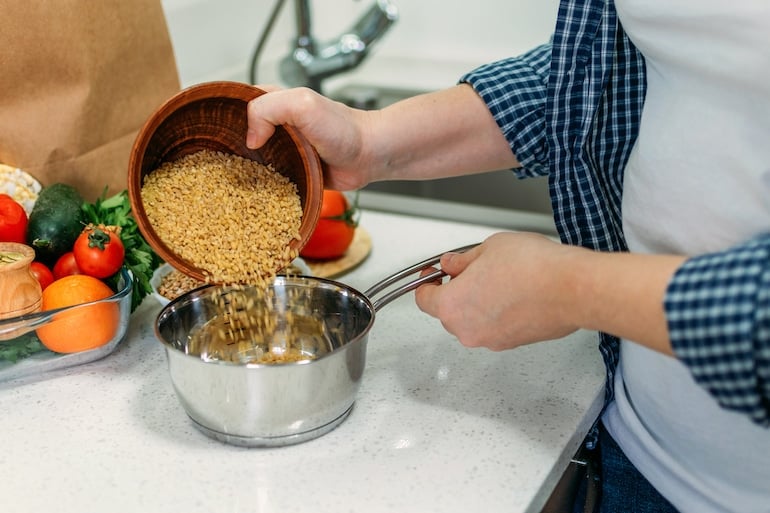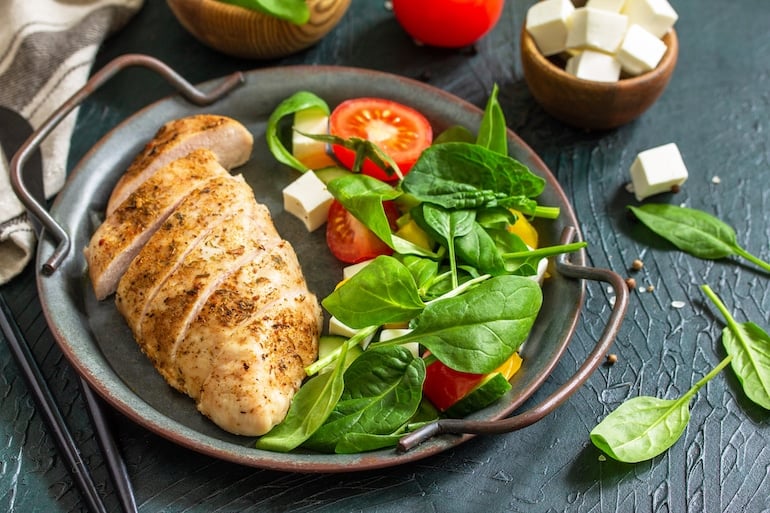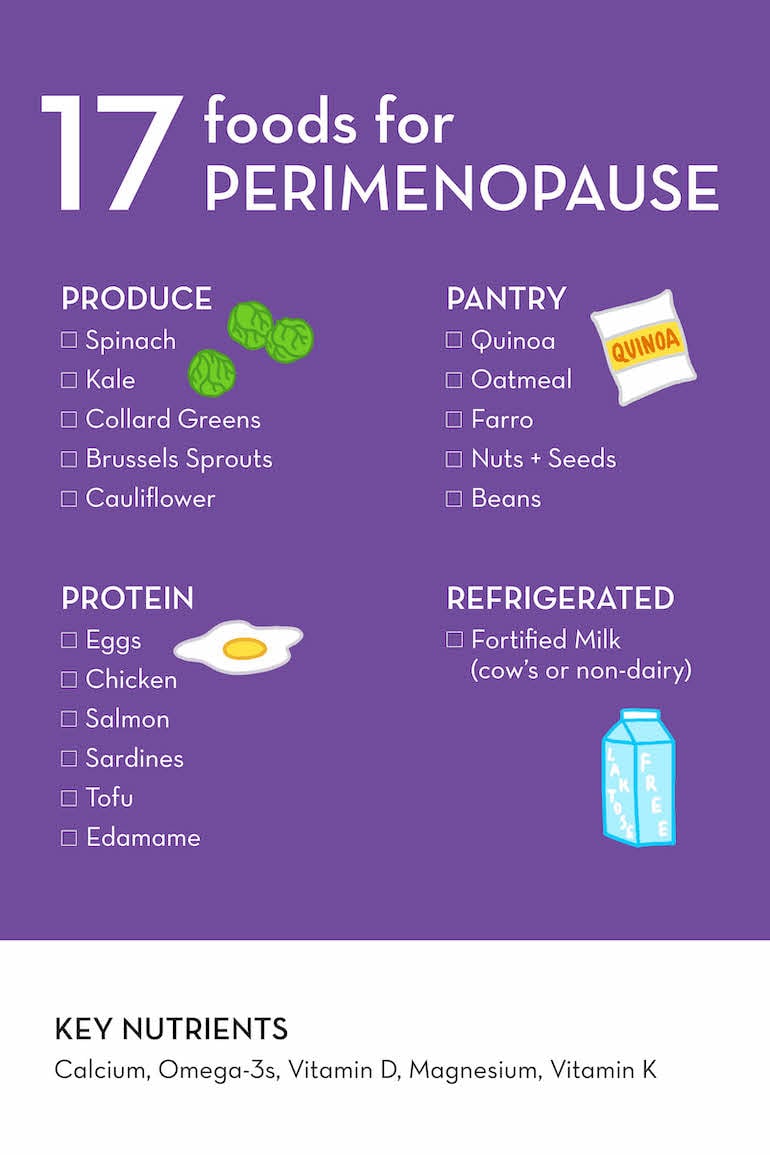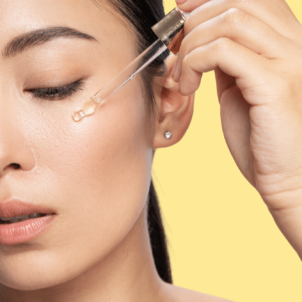In Your 40s? You’ll Want to Add These 7 Foods To Your Diet
Perimenopause can be a confusing time with uncomfortable symptoms, but you don’t have to just grin and bear it. Adopt a perimenopause diet to help to ease symptoms with these foods.
Perimenopause is something that isn’t commonly talked about (but should be). And yet, the symptoms—insomnia, hot flashes, mood changes—can be life-altering. Many women in the early stages of perimenopause may not even realize that the symptoms they’re experiencing are a result of hormonal shifts.
While you may feel like leaning into comfort foods to cope during this time, getting smart about your nutrition can actually support your body and improve symptoms. Find out how hormonal changes during perimenopause can change your nutritional needs and why a targeted perimenopause diet can help you feel more like yourself.
What is perimenopause?
Perimenopause is defined as the years that precede menopause, the time when you stop menstruating, according to The American College of Obstetricians and Gynecologists (ACOG). On average, menopause happens at age 51, and symptoms of perimenopause can persist for four to eight years as your body makes the transition, notes The North American Menopause Society (NAMS).
It all starts, though, in your mid- to late-30s when your hormones start to shift, says Erica Leon, RDN, an expert in menopause nutrition. Perimenopause typically occurs in your 40s. Notably, levels of estrogen and progesterone begin to decrease, though as they do so, these hormones may also fluctuate. The most likely initial sign of perimenopause? Your periods begin to change. “Some women notice that they are longer, heavier, or their cycles shorten,” she explains.
That hormone rollercoaster is what brings about symptoms such as perimenopause weight gain, difficulty sleeping, mood changes, low mood, hot flashes, loss of libido, brain fog, joint pain, and vaginal and skin dryness, among many others, says Leon.
Why your diet should shift during perimenopause
“Estrogen has an important role in every single system in the body,” Leon explains. For that reason, your nutritional needs may also change. For example, estrogen is a bone-preserving hormone, and so the loss of estrogen causes bone loss, notes the National Osteoporosis Foundation. In this case, there are certain nutrients you want to make sure you’re getting enough of to keep your skeleton strong. In other circumstances, certain foods may help you manage the symptoms of perimenopause.

“Perimenopause is the perfect time to start paying attention to your health. The things you could get away with when you were younger, such as poor diet habits, start to catch up with you now,” says Leon. And that doesn’t mean that all the focus is on your weight. In fact, focusing too much on weight often leads to maladaptive eating habits that affect your health in significant ways.
Leon notes that 15 percent of midlife women meet the criteria for an eating disorder, and a big part of this is triggered by chronic dieting and restrictive eating habits. Overall, eating a balanced diet, along with lifestyle changes that make good eating habits easier to stick with, such as practicing stress management, adequate sleep, and strength training, are vital for keeping you well. That umbrella approach to your health can keep you out of the yo-yo diet cycle that can be so damaging.
For a balanced diet that also supports your body during perimenopause, make you’re incorporating the following foods into your routine.
7 Foods That Should Be Part of Every Perimenopause Diet
When you’re thinking about the best foods for perimenopause, these are seven great foods that decrease the risk of chronic disease and may even temper bothersome symptoms:
Tofu
Whole soy foods, including tofu, tempeh, edamame, and soy milk, are one of the best additions that you can make to your diet during perimenopause. “I recommend my clients try soy foods first,” says Leon. Soy foods contain soy isoflavones, substances that, when broken down, have estrogen-like properties. “These can act as very weak forms of estrogen,” she explains. In fact, research has found that those following a low-fat plant-based diet that includes 1.2 cups of cooked soybeans daily for 12 weeks reported that their hot flashes decreased by 79 percent compared to the control group, found a 2021 study in Menopause. (The research was done on postmenopausal women but hot flashes are a common symptom during perimenopause, per ACOG.)

Fortified milk
Whether you like almond or oat or traditional cow’s milk, make sure that whatever you’re drinking contains the bone-strengthening duo calcium and vitamin D. “So many women who have a history of dieting or an eating disorder or who are trying to keep their weight low have a higher risk of not eating enough calcium and vitamin D,” says Leon. That can leave you vulnerable to osteopenia (weak bones) or osteoporosis (bone loss) as you age. Good bone health comes from a food-first approach.
If you’re drinking cow’s milk, it likely supplies an excellent source of calcium and a good source of vitamin D. If you’re drinking plant-based milk, like almond, coconut, hemp, or oat, make sure that yours is fortified. Still, some women may need to supplement their diet, as calcium and vitamin D deficiency are common. Got Calcium is a vegan source of calcium with 48 percent of your recommended daily value while Here Comes the Sun contains 250 percent of your recommended daily vitamin D intake.
Salmon
Fatty fish, such as salmon, sardines, and mackerel, supply omega 3 fatty acids. Not only is this type of fat healthy for your heart, but it’s especially good during perimenopause, says Leon. “It’s important to get enough dietary fats into your diet because your body needs dietary fat to make hormones,” she says. What’s more, your risk of metabolic dysfunction, a risk factor for heart disease and type two diabetes, increases around menopause, so eating heart-healthy sources of fat is important.
In general, Mediterranean patterns of eating—rich in fatty fish and monounsaturated fats like olive oil and nuts—is the type of diet that Leon suggests her clients follow to feel their best. The American Heart Association recommends eating two fish meals per week. If you struggle to get in the recommended servings of fish each week, you may also want to consider adding an omega-3 fish oil supplement, like OMG! Omega The Great.
Whole Grains
There’s no reason to stay away from carbs, especially whole grains, like whole-wheat bread or pasta, quinoa, farro, oatmeal, or sorghum. “You really want to try to make sure you’re not on a no- or low-carb diet,” says Leon. “Whole grains also have phytoestrogens that are helpful in managing symptoms,” she explains.

Dark Leafy Greens
There are several reasons to sneak in more dark leafy greens (like spinach, kale, collards) into your diet when you can. For one, they offer a source of calcium—not as much as dairy, but they’re a prime plant-based option to help you meet your needs. These veggies are also packed with magnesium and vitamin K. “Women who are dieting tend to have lower intakes of these two nutrients,” says Leon. Magnesium is a mineral that’s involved in 300 enzymatic reactions in the body and tends to become depleted in times of stress, research shows. Vitamin K, on the other hand, is needed for bone health.
Lean Meat
Many women in perimenopause find that their weight doesn’t change, but the distribution of body fat does, accumulating around the waist, according to NAMS. Along with possible increased belly fat, lean body mass (e.g. muscle mass) also decreases during this time. To maintain muscle, which is vital for a zippy metabolism and physical function, Leon recommends both strength training and adequate protein consumption. You can get this through animal-based lean proteins (like eggs, chicken, fish, shellfish, certain cuts of pork and beef), as well as Greek yogurt and plant-based sources, such as legumes, nuts, and seeds.

Beans
Along with supplying plant protein (a half-cup has about 8 grams of protein, per USDA) and magnesium, beans are another source of phytoestrogens, says Leon. What’s more, if you are concerned about perimenopause weight gain or gaining fat, adding beans and lentils to your diet is a good strategy. These foods, rich in filling fiber and protein and low on the glycemic index, have been shown to help with weight loss without having to restrict your calorie intake, found a review and meta-analysis of 21 randomized controlled trials, published in The American Journal of Clinical Nutrition. Adding beans to a meal increases satiation because they are digested slowly and prompt a lower blood sugar response, all of which help keep your appetite on an even keel, the researchers say. They suggest eating one serving of pulses per day. Try them atop salads, in soups, or in a grain bowl. (We’re also sneaking them into these brownies and they make an excellent filling for enchiladas.)
Save this shopping list for our next trip to the grocery store!










